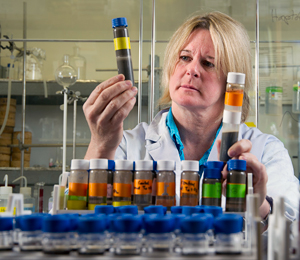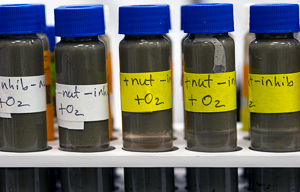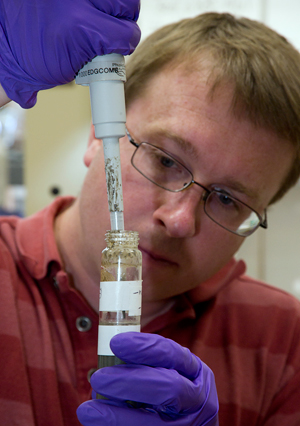Protists are the Rodney Dangerfields of marine microbes. Although marine bacteria emerged as heroes in the Deepwater Horizon affair, gobbling up vast amounts of spilled oil and gas, few people paid much attention to protists—those mostly single-celled creatures such as the Amoeba and Paramecium thatyou may recall from high school. But protists get respect from Virginia Edgcomb, a microbial ecologist at Woods Hole Oceanographic Institution (WHOI). She knows they are a critical link in the marine food web: Protists eat bacteria, and are eaten by zooplankton and larval fish. If it weren’t for protists, much of the enormous nutrient reservoir that includes bacteria would not reach large animals such as fish, dolphins, whales, and seabirds. “Everyone knows that bacteria play a major role in degrading hydrocarbons,” she said, “but it’s kind of unknown the extent to which the protists are involved.” Edgcomb is investigating whether protists play an overlooked role, especially in seafloor sediments. Protists themselves probably don’t eat a lot of oil, Edgcomb said. But they do graze voraciously on some bacteria that eat oil. Some kinds of protists have even been found to have a strong preference for bacteria that eat hydrocarbons. In the process, protists may dramatically affect how much oil gets eaten. That effect isn’t what you might think at first. Edgcomb said that protists chowing down on oil-eating bacteria might actually increase the amount of oil that gets eaten. That’s because bacteria eat the most when they are reproducing rapidly and their population is growing fast. Without any curbs on bacteria's population numbers, their growth rate usually will level off and then decline. When that happens, oil consumption may go down. But when protists are around and continually grazing upon them, the bacteria can stay in a rapid growth phase, continuing to eat petroleum compounds and reproduce at a rapid rate. To test this possibility, Edgcomb is examining whether bacteria digest oil differently in the presence and absence of protist predators. After the Deepwater Horizon accident, when researchers found brown, oily goo on the bottom of the Gulf of Mexico, she knew she wanted to take a close look at what the protists and bacteria under the goo were doing, in a variety of circumstances and conditions. Edgcomb’s colleague Andreas Teske, a microbiologist at the University of North Carolina, sent her samples of sediment that he collected from a site a few miles from the Deepwater Horizon wellhead. He had been studying the site even before the blowout, because it’s an area where bacteria have adapted to the presence of methane and other hydrocarbons that seep naturally out of the seafloor. Edgcomb divided the samples into test tubes, along with some of the seawater collected from the site. She killed the protists in some tubes and left them alone in others. Some tubes were given a steady supply of oxygen, while others were tightly sealed so the oxygen would be depleted as the microbes consumed oil. Some tubes were given supplements of nitrogen and phosphorus, nutrients that microbes require to grow. All tubes included whatever hydrocarbons were in the samples originally. Each one also received a shot of fossil diesel oil that WHOI chemist Chris Reddy has studied thoroughly to determine all the chemical compounds that are produced when this type of oil is degraded by bacteria of various kinds. After allowing Edgcomb’s test tubes to incubate, Reddy and research assistant Catherine Carmichael are analyzing what hydrocarbon compounds remain to determine which chemical compounds in the oil were eaten in each tube. The ultimate goal is to see whether the presence of protists had any effect on what the bacteria did. Edgcomb and research associate Dave Beaudoin will also assess what species of protists were present in the sediments before and after the experiment, to see whether species composition shifted in response to the sudden influx of “foreign” Deepwater Horizon hydrocarbons. Edgcomb has a hunch that protists will turn out to be interesting and important players, when it comes to how chemicals such as petroleum are broken down and recycled in marine environments. This research was funded by a grant from the WHOI Deep Ocean Exploration Institute. Originally published: July 14, 2011 Last updated: August 15, 2013 | |||||||||||||||||||||||||
Copyright ©2007 Woods Hole Oceanographic Institution, All Rights Reserved, Privacy Policy. | |||||||||||||||||||||||||




